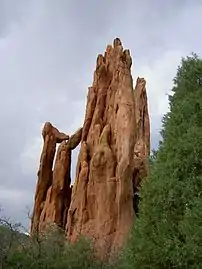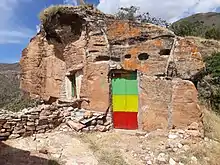
A pinnacle, tower, spire, needle or natural tower (German: Felsnadel, Felsturm or Felszinne) in geology is an individual column of rock, isolated from other rocks or groups of rocks, in the shape of a vertical shaft or spire. is a natural geomorphological shape and a structural denudation shape of the relief. It is about an isolated, tall and often also slender column or prism, reminiscent of a tower in its shape. A specific type of rock tower is the rock needle.[1]
Formation

The rock tower was created as a result of mechanical erosion, namely the gradual breakdown and destruction of a flat plateau or a rocky mountain ridge.[2] Its shape is the result of mechanical weathering and the attitude of the rock, or the subsidence of the slope. On the sea coast, rock towers are created by abrasion and isolation of the more resistant parts of the worn and abraded coast (cliff).[3]
Distribution
Rock towers are found in various parts of the world. They are found on the edges of high mountains and tabular plateaus, such as the buttes in arid regions, or on heavily disturbed rocky coasts. However, they are most often found in the area of sandstone rock towns.[4]
Examples are the summits of the Aiguille du Midi in the Mont Blanc massif in France, the almost 43-metre-high Barbarine on the south side of the Pfaffenstein hill near Königstein in Germany, or the Bischofsmütze, the Drei Zinnen and the Vajolet Towers in the Dolomites, which are rich in such towers. An area of limestone formations within Nambung National Park, near the town of Cervantes, Western Australia, is known as The Pinnacles.
Gallery




 The Pinnacles, Nambung National Park, Western Australia
The Pinnacles, Nambung National Park, Western Australia
 Top of the Rock Golf Course Limestone Pinnacles (excavated to a depth of 60 m in areas), Branson, Missouri, USA
Top of the Rock Golf Course Limestone Pinnacles (excavated to a depth of 60 m in areas), Branson, Missouri, USA Debre Sema'it rock church on the top of a pinnacle in Ethiopia
Debre Sema'it rock church on the top of a pinnacle in Ethiopia
See also
References
- ↑ Základy geomorfologie: vybrané tvary reliéfů. Univerzita Palackého. pp. 57–58. ISBN 978-80-244-1749-3.
- ↑ Základy geomorfologie: vybrané tvary reliéfů. Univerzita Palackého. pp. 57–58. ISBN 978-80-244-1749-3.
- ↑ Atlas skalních, zemních a půdních tvarů (1 ed.). Academia. pp. 68–69.
- ↑ Atlas skalních, zemních a půdních tvarů (1 ed.). Academia. pp. 68–69.
Bibliography
- Jiří Adamovič, Václav Cílek, Radek Mikuláš : Atlas of Sandstone Rock Cities, Academia Praha 2010, ISBN 978-80-200-1773-4
- Josef Rubín, Břetislav Balatka, Vojen Ložek, Miroslav Malkovský, Vlastimil Pilous, Jan Vítek : Atlas of rock, earth and soil forms, Academia Prague, 1986, 1st edition, 388 pages, 21-033-86
External links
- Vista aèria del Desert dels Pinacles Google Maps